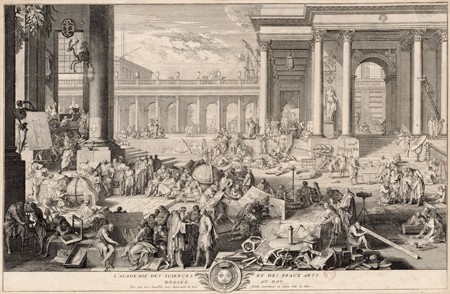In a print dated 1698, the French engraver Sébastien Leclerc (1637–1714) illustrated the forms of knowledge that became part of the doctrine of academic practice during the reign of Louis XIV. Flanked by columns of the Corinthian order, an open court offers space for experimentation, demonstration, and debate. To the left, students gather around a half-draped globe, while those to the right trace the heliocentric movement of the planets. Such inquiries demanded accuracy and precision, in the pursuit of which academicians employed new tools and techniques: compasses, scales, and telescopes are scattered farther to the right, their half-opened state suggesting constant use. These actions implied no less than the collapse of episteme and techne—thinking and doing, a distinction dear to Aristotle and his followers—and the embrace of a rationality enlivened by real-world application. For the engraver, the message is clear: knowledge and expertise are as cerebral as they are social, and their proper attainment involved both abstract and material realms.
Leclerc’s image serves as an apt introduction to the research undertaken during this fellowship year, in which I studied the complex relationship between French academic architectural theory and the reality of building sites and craft practices at the end of the seventeenth century. How, my dissertation asks, did the codification of the building trades, the regulation of construction, and project financing influence the formalization of architecture as a discipline during the reign of Louis XIV? From assembly to materials, from measurement techniques to the organization of labor, my aim is to describe the ways in which the realms of expertise and material know-how intervened in architecture as both discipline and profession during the Grand Siècle. What informs the questions posed throughout my dissertation are the connections between high and low, between intellect and practical experience, which were forged in the context of French absolutism and the centralization, systematization, and mobilization of the arts and sciences it engendered.
To paint this picture in terms of theory and practice, the project is composed of four thematic sections, each structured according to a concept then undergoing conceptual reorientation: precision, stability, matter, and commodity. Central and often surprising is how technical and economic concerns found their way into the very precepts instituted by the Académie royale d’architecture (established 1671). This appropriation of artisanal knowledge by the academy helped siphon authority from the craft guilds. Several projects by academicians, including the 1673 re-edition of L’Architecture françoise (1624) by François Blondel (1618–1686) and the publication of L’Architecture pratique (1691) by Pierre Bullet (1613–1716)—both manuals aimed at aspects such as municipal building codes and the cost and measurement of materials—asserted expert guidance in the realm of practice as well as theory.
These publications also marked architecture’s empirical reorientation, whereby rationalized experience constituted knowledge. Consider, for instance, a practice like the toisé, or precise assessment of materials for contractual purposes. According to the Académie française, the word meant “to measure by the toise” (six French pieds, or feet), the official unit for architecture, astronomy, and mapmaking. References to this legal and intellectual regulation are found across academic texts, including Mesure de la terre (1671) by Jean Picard (1620–1682) and Les Édifices antiques de Rome dessinés et mesurés très exactement (1682) by Antoine Desgodets (1653–1728), as well as Bullet’s Architecture pratique, mentioned above. Here, the attention placed on exactness presented a contradiction: On the one hand, it aimed to establish dimensional standards, thereby asserting the status of mathematics as a universal truth. On the other hand, it ultimately concerned financial calculation, speaking to the least stable of considerations. Indeed, the toisé always linked architectural and economic probability, given that numerical precision was a prerequisite for fiscal calculability and, by extension, the realization of construction.
Such maneuverings were not without consequences. If Leclerc’s image hinted at a transparency between art and science, his inclusion of the man kneeling to the right offers instead a rebuttal. Surrounded by instruments of optical enhancement, he lifts a plank for study. Obscured from our vantage point, the anamorphic outline of a skull is sketched across its surface—here an illusionistic memento mori amid representations of scientific progress. The remainder of the dissertation concerns the compound ways in which theory and practice conflicted or coalesced at the very point of construction. These include a study of dressed stonework and modern statics; a consideration of ironwork’s decorative and structural function, as well as its practical and symbolic role for Cartesian science; and an analysis of the residential fireplace, as developed at Versailles by Jules Hardouin Mansart (1646–1708) among others, circulated by commercial printers in Paris, and theorized for its safety and sensorial merits by natural philosophers shortly thereafter.
